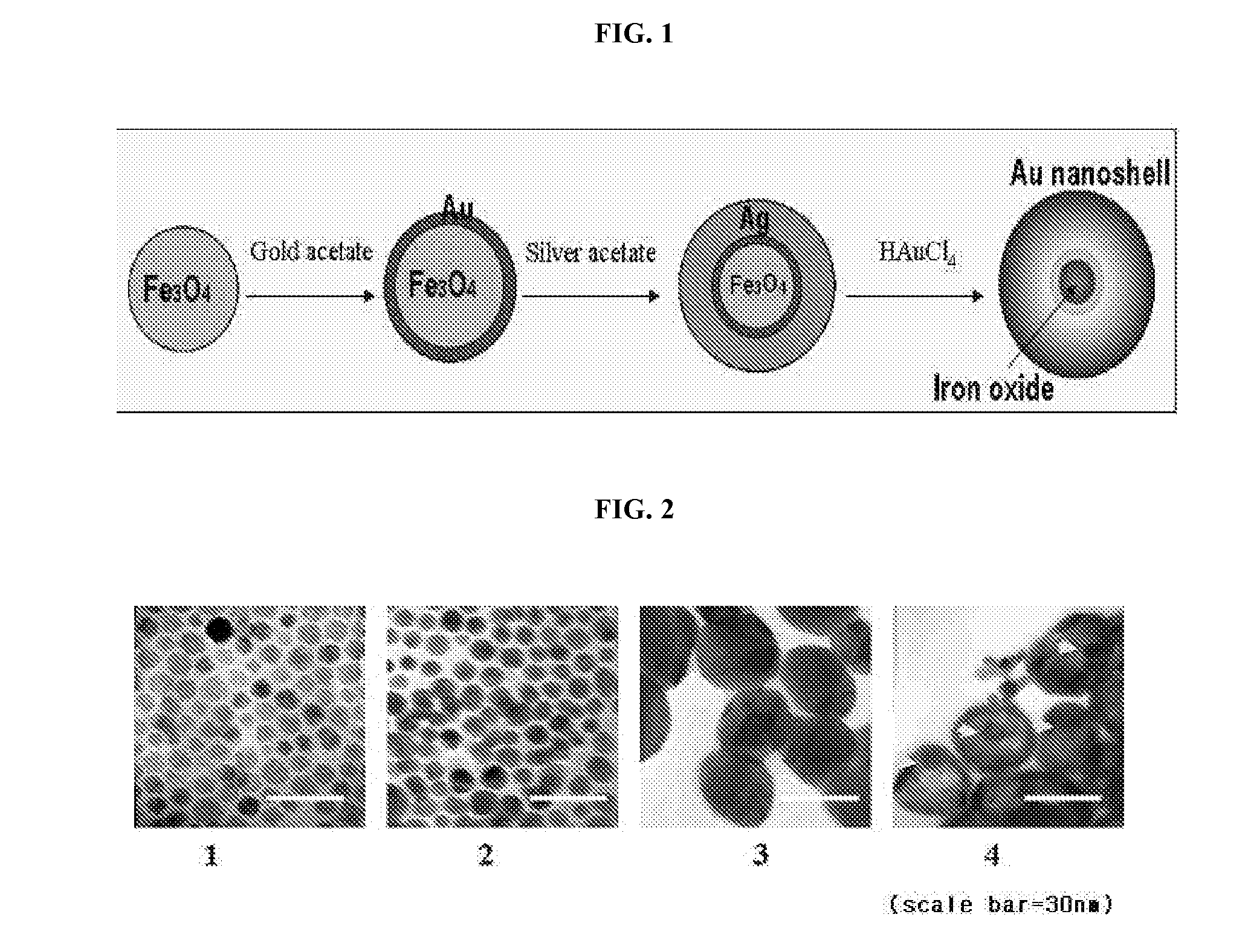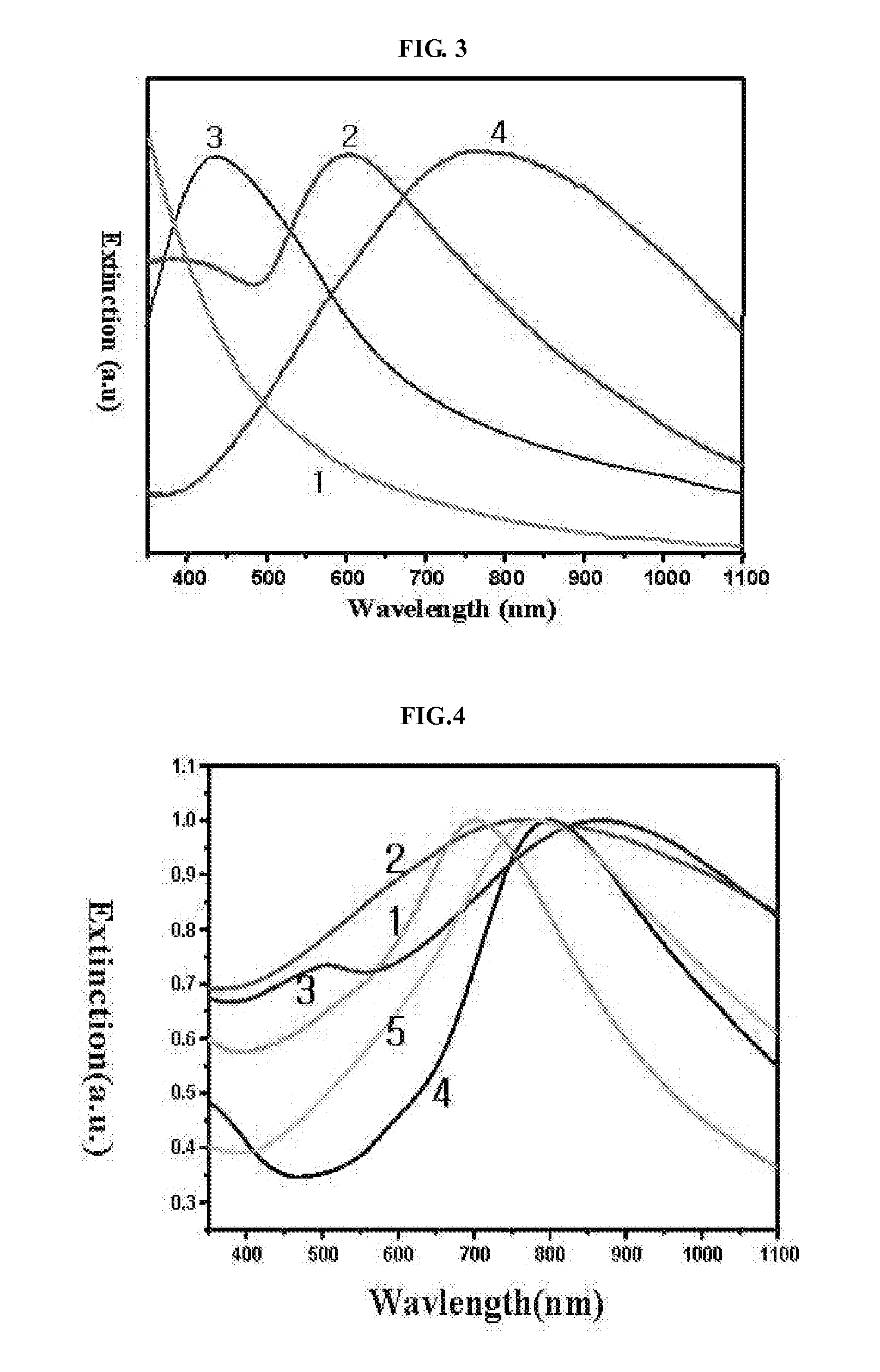Gold nanocages containing magnetic nanoparticles
a magnetic nanoparticle and gold nanoparticle technology, applied in the field of gold nanoparticle cages containing magnetic nanoparticles, can solve the problems that the visible region light cannot be used to analyze turbid samples such as blood or skin without a separate purification process or to apply them to the human body, and the fundamental limitations of optical analysis methods also exist in the analysis methods or applications that use near-infrared properties,
- Summary
- Abstract
- Description
- Claims
- Application Information
AI Technical Summary
Problems solved by technology
Method used
Image
Examples
example 1
Preparation of Gold-Coated Iron Oxide Nanoparticles (Fe3O4@Au)
[0048]To 20 ml of benzyl ether, 0.71 g (2 mmol) of iron(III) acetylacetonate, 2 ml (6 mmol) of oleic acid, 2 ml (0-4 mmol) of oleylamine and 2.58 g (10 mmol) of 1,2-hexadecanediol were added, and the mixture solution was rapidly stirred in an argon atmosphere.
[0049]After the solution was allowed to react at 200° C. for 2 hours, argon gas was removed, followed by reaction at 290° C. for 1 hour. After completion of the reaction, the solution was cooled at room temperature and washed several times with ethanol. Finally, Fe3O4 was separated from the solution using a magnet, and 0.1 g of the separated Fe3O4 was dispersed in 40 ml of benzyl ether.
[0050]To the dispersion, 0.7 g (2.2 mmol) of gold(III) acetate, 3.1 g (12 mmol) of 1,2-hexadecanediol, 0.5 ml (0-1.5 mmol) of oleic acid and 3 ml (0-6 mmol) of oleylamine were added, and the mixture solution was rapidly stirred in an argon atmosphere, while it was allowed to react at 1...
example 2
Preparation of Silver-Coated Iron Oxide Nanoparticles (Fe3O4@Au@Ag)
[0052]Fe3O4@Au prepared in Example 1 was dispersed in 100 ml of hexane, and the dispersion was mixed with 10 mM MUA (mercaptoundecanoic acid). The mixture solution was sonicated for 1 hour, and then Fe3O4 was separated from the solution using a magnet. The separated Fe3O4 was washed several times with ethanol, and then dispersed in 100 ml of triple-deionized water.
[0053]The dispersed solution was adjusted to a pH of 10 by the addition of 100 mM NaOH, and then diluted 10-fold by adding 9 ml of triple-deionized water to 1 ml of the solution. After the solution was adjusted to a pH of 10 by the addition of 100 mM NaOH, and then 0.5 ml of 100 mM AgNO3 was added thereto. The solution was refluxed with rapid stirring at 100° C., and then 1 ml of 50 mM sodium citrate was added thereto dropwise within 1 minute. The solution was allowed to react further for 20 minutes, thus preparing iron oxide nanoparticles (Fe3O4@Au@Ag) com...
example 3
Preparation of Iron Oxide Nanoparticle-Containing Gold Nanocages (Fe3O4@Au@Au)
[0054]The Fe3O4@Au@Ag solution prepared in Example 2 was centrifuged three times at 10000 rpm for 10 minutes each time, and then unreacted sodium citrate was washed out. The solution was dispersed in 10 ml of triple-distilled water, and 100 mg of PVP (polyvinylpyrolidone) was dissolved therein. The mixture solution was refluxed with rapid stirring at 100° C., and then 0.8 ml of 10 mM HAuCl4 was added thereto dropwise at a constant rate of 0.425 ml / min.
[0055]After the addition of HAuCl4, the solution was allowed to react for 20 minutes to stabilize. Then, the reaction solution was cooled at room temperature, and an excess amount of NaCl was added thereto to remove white AgCl, thus producing hollow-type nanostructures. The resulting solution was centrifuged three times at 10000 rpm for 10 minutes each time, and then gold shells were collected from the solution using a magnet, thus preparing iron oxide nanopa...
PUM
| Property | Measurement | Unit |
|---|---|---|
| Thickness | aaaaa | aaaaa |
| Shape | aaaaa | aaaaa |
| Magnetism | aaaaa | aaaaa |
Abstract
Description
Claims
Application Information
 Login to View More
Login to View More - R&D
- Intellectual Property
- Life Sciences
- Materials
- Tech Scout
- Unparalleled Data Quality
- Higher Quality Content
- 60% Fewer Hallucinations
Browse by: Latest US Patents, China's latest patents, Technical Efficacy Thesaurus, Application Domain, Technology Topic, Popular Technical Reports.
© 2025 PatSnap. All rights reserved.Legal|Privacy policy|Modern Slavery Act Transparency Statement|Sitemap|About US| Contact US: help@patsnap.com



